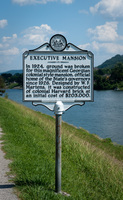 | Back to e-WV
| Back to e-WV
 The West Virginia Encyclopedia
The West Virginia Encyclopedia
 | Back to e-WV
| Back to e-WV
 The West Virginia Encyclopedia
The West Virginia Encyclopedia

Roadside markers throughout West Virginia mark the locations of significant historical events, as well as prehistoric sites and many geological and natural features. The popular program was begun in 1934. Since then, nearly 1,000 markers have been installed on our state’s roadsides.
The marker program was first managed by the Commission on Historic and Scenic Highway Markers, which initially identified 440 sites for marking. These markers were erected in 1937, with funding from the Federal Emergency Relief Administration, an agency of President Franklin Roosevelt’s New Deal. The State Road Commission cooperated in installing the markers. The original basic design, 42 inches wide and 30 inches high, with a circular state seal at the top, is still in use today. The handsome monuments, mounted on round steel posts, have been made of cast aluminum for most of the program’s history. The short historical message is repeated on both sides, although a few markers have a different text on the front and back. The first marker was installed in Charleston April 26, 1937, detailing the history of the State Capitol.
While activity waned after the early years, the centennial of the Civil War and of West Virginia statehood revived interest in the marker program in the 1960s. Existing markers were inventoried, damaged and missing markers were replaced, and nearly 300 additional sites were marked. Since that time, new markers have been added yearly, as funds permit. Administrators point to the high cost of new markers, as well as vandalism, accidental damage, and inadequate funding as particular problems. In recent years, markers have been financed largely by private donations and by funds provided by West Virginia Celebration 2000 and administered by the West Virginia Humanities Council.
Today, the roadside markers program is operated by the Archives and History Section of the West Virginia Department of Arts, Culture and History, with the cooperation of the Division of Highways. New markers are approved by the Archives and History Commission. Guides to the texts and locations of roadside markers have been issued from time to time, most recently in 2021.
Marking our Past: West Virginia's Historical Highway Markers. Charleston: State Archives, 2002.